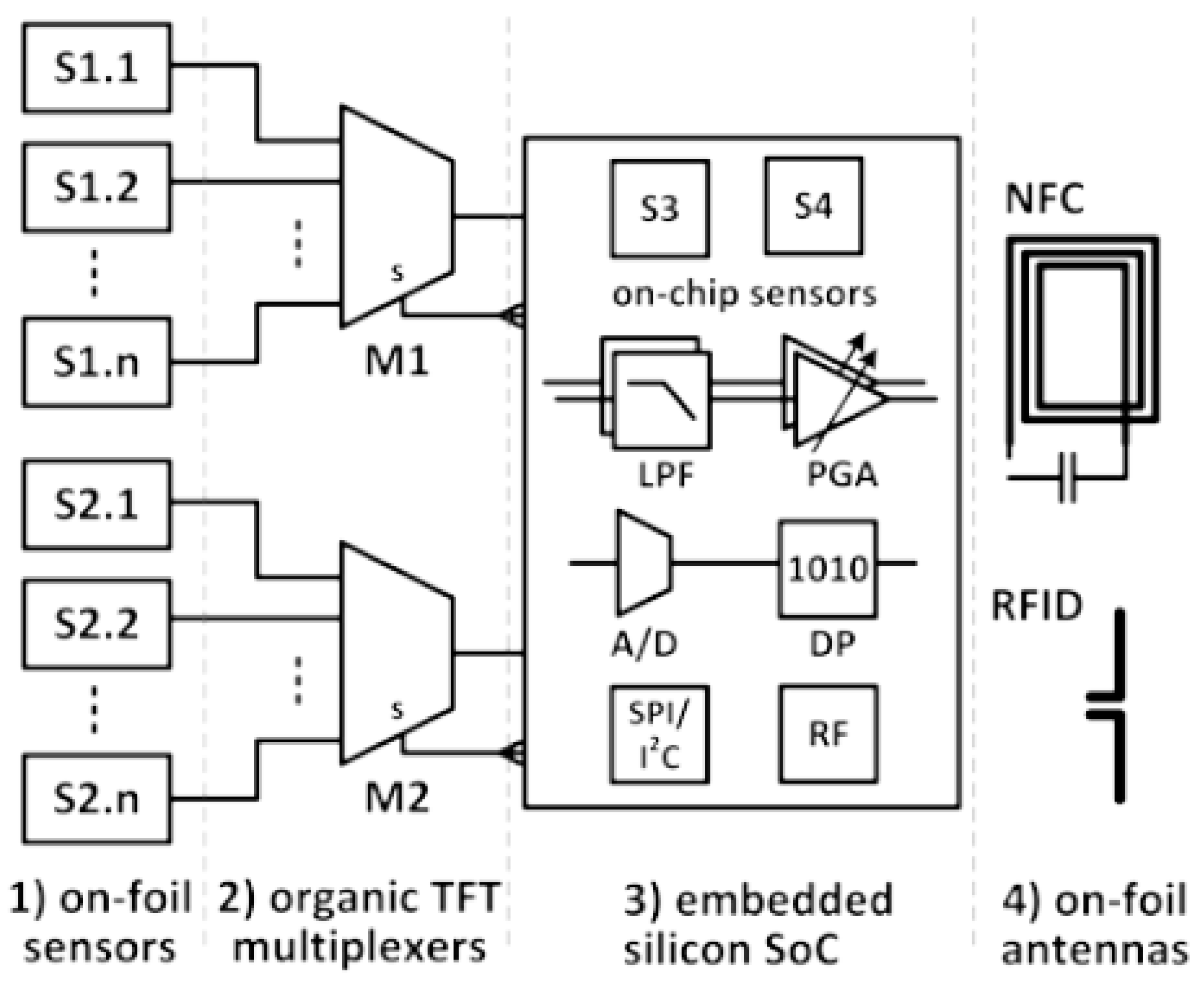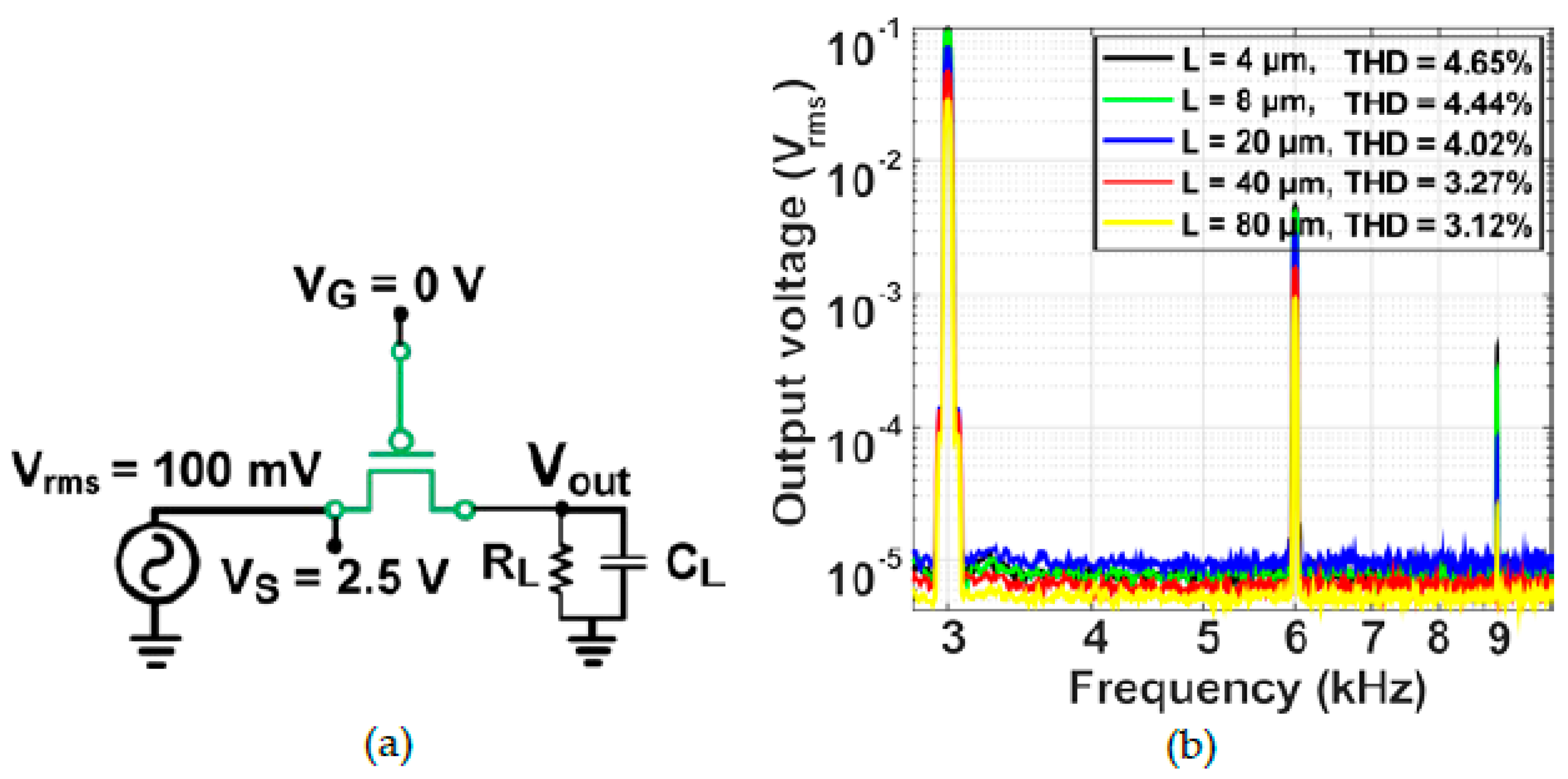Ultra-Thin Sensor Systems Integrating Silicon Chips with On-Foil Passive and Active Components †
Abstract
:1. Introduction
2. Materials and Methods
3. Results and Discussion
4. Conclusions
Author Contributions
Acknowledgments
Conflicts of Interest
References
- Afsar, Y.; Moy, T.; Brady, N.; Wagner, S.; Sturm, J.C.; Verma, N. Large-scale Acquisition of Large-area Sensors Using an Array of Frequency-hopping ZnO Thin-Film-Transistor Oscillators. ISSCC Dig. Tech. Pap. 2017, 256–257. [Google Scholar] [CrossRef]
- Moy, T.; Huang, L.; Rieutort-Louis, W.; Wu, C.; Cuff, P.; Wagner, S.; Sturm, J.C.; Verma, N. An EEG Acquisition and Biomarker-Extraction System Using Low-Noise-Amplifier and Compressive-Sensing Circuits Based on Flexible, Thin-Film Electronics. IEEE J. Solid-State Circ. 2016, 52, 309–321. [Google Scholar] [CrossRef]
- Quintero, A.V.; Molina-Lopez, F.; Smits, E.C.P.; Danesh, E.; Van den Brand, J.; Persaud, K.; Oprea, A.; Barsan, N.; Weimar, U.; De Rooij, N.F.; et al. Smart RFID Label with a Printed Multisensor Platform for Environmental Monitoring. Flex. Print. Electron. 2016, 1, 1–13. [Google Scholar] [CrossRef]
- Papadopoulos, N.P.; De Roose, F.; Van der Steen, J.P.J.; Smits, E.C.P.; Ameys, M.; Dehaene, W.; Genoe, J.; Myny, K. Toward Temperature Tracking With Unipolar Metal-Oxide Thin-Film SAR C-2C ADC on Plastic. IEEE J. Solid-State Circ. 2018, 1–10. [Google Scholar] [CrossRef]
- Alavi, G.; Sailer, H.; Albrecht, B.; Harendt, C.; Burghartz, J.N. Optimized Adaptive Layout Technique for Hybrid Systems in Foil. Proc. EMPC 2017. [Google Scholar] [CrossRef]
- Elsobky, M.; Mahsereci, Y.; Yu, Z.; Richter, H.; Burghartz, J.N.; Keck, J.; Klauk, H.; Zschieschang, U. Ultra-Thin Smart Electronic Skin Based on Hybrid System-in-Foil Concept Combining Three Flexible Electronics Technologies. Electron. Lett. 2018, 54, 338–340. [Google Scholar] [CrossRef]
- Elsobky, M.; Albrecht, B.; Richter, H.; Burghartz, J.N.; Ganter, P.; Szendrei, K.; Lotsch, B.V. Ultra-Thin Relative Humidity Sensors for Hybrid System-in-Foil Applications. IEEE Sens. 2017. [Google Scholar] [CrossRef]
- Elsobky, M.; Elattar, M.; Alavi, G.; Letzkus, F.; Richter, H.; Burghartz, J.N.; Strecker, M.; Klauk, H.; Zschieschang, U. A Digital Library for a Flexible Low-Voltage Organic Thin-Film Transistor Technology. Org. Electron. 2017, 50, 491–498. [Google Scholar] [CrossRef]





| Inductance (µH) | Resistance (Ω) | Size (mm2) | Turns | Trace Width/Spacing (µm/µm) |
|---|---|---|---|---|
| 3.6 | 9.2 | 41 × 55 | 5 | 600/300 |
| 5.2 | 16.6 | 41 × 71 | 5 | 400/400 |
| 3.3 | 10.5 | 35 × 40 | 5 | 400/200 |
| 4.4 | 41.3 | 25 × 35 | 5 | 100/100 |
| 13.8 | 81.3 | 25 × 35 | 10 | 100/100 |
| 7.7 | 20.1 | 35 × 40 | 10 | 400/200 |
| 11.6 | 27 | 35 × 40 | 15 | 400/200 |
Publisher’s Note: MDPI stays neutral with regard to jurisdictional claims in published maps and institutional affiliations. |
© 2018 by the authors. Licensee MDPI, Basel, Switzerland. This article is an open access article distributed under the terms and conditions of the Creative Commons Attribution (CC BY) license (https://creativecommons.org/licenses/by/4.0/).
Share and Cite
Elsobky, M.; Alavi, G.; Albrecht, B.; Deuble, T.; Harendt, C.; Richter, H.; Yu, Z.; Burghartz, J.N. Ultra-Thin Sensor Systems Integrating Silicon Chips with On-Foil Passive and Active Components. Proceedings 2018, 2, 748. https://doi.org/10.3390/proceedings2130748
Elsobky M, Alavi G, Albrecht B, Deuble T, Harendt C, Richter H, Yu Z, Burghartz JN. Ultra-Thin Sensor Systems Integrating Silicon Chips with On-Foil Passive and Active Components. Proceedings. 2018; 2(13):748. https://doi.org/10.3390/proceedings2130748
Chicago/Turabian StyleElsobky, Mourad, Golzar Alavi, Björn Albrecht, Thomas Deuble, Christine Harendt, Harald Richter, Zili Yu, and Joachim N. Burghartz. 2018. "Ultra-Thin Sensor Systems Integrating Silicon Chips with On-Foil Passive and Active Components" Proceedings 2, no. 13: 748. https://doi.org/10.3390/proceedings2130748
APA StyleElsobky, M., Alavi, G., Albrecht, B., Deuble, T., Harendt, C., Richter, H., Yu, Z., & Burghartz, J. N. (2018). Ultra-Thin Sensor Systems Integrating Silicon Chips with On-Foil Passive and Active Components. Proceedings, 2(13), 748. https://doi.org/10.3390/proceedings2130748




